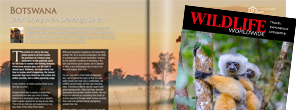Borneo: A Special Place for Mammals

In April this year I was fortunate enough to travel with my wife to the Malaysian state of Sabah on the island of Borneo, our second visit to this fascinating part of South-east Asia.
Having previously visited Sepilok, the Kinabatangan River and the superb Borneo Rainforest Lodge in Danum Valley, we had a good idea of what to expect and indeed, the first part of this trip followed a similar programme. We began with a night in Sepilok to visit the sun bear and orangutan rehabilitation centres, before moving on to the Kinabatangan River, where a couple of nights at the excellent Kinabatangan Wetlands Resort rewarded us with fantastic sightings of a variety of primates, reptiles and birds.

Exploring the area’s waterways through a mix of morning, afternoon and evening boat safaris, we saw six species of primate, including orang-utans, proboscis monkeys, long-tailed and pig-tailed macaques, and silvery and maroon langurs, alongside a close encounter with a herd of Asian elephants, a species that we’d missed first time round.

From the river we travelled overland, via the Gomantong Caves (the smell every bit as bad as I remembered!) to Deramakot, a 50,000-hectare Forest Reserve just outside Telupid. In the absence of a commercial lodge and subject to selective logging, Deramakot has remained off the tourist trail and offers a very different experience to the better-known reserves of Tabin and Danum Valley. How long it stays this way remains to be seen as it has a growing reputation for being one of the best sites for seeing some of South-east Asia’s rarest mammals. This is in no small part due to the fact that, unlike more tightly regulated parks, here you are free to follow your own programme and can therefore spend more time in the field; this is also a testament to the excellent management of the forest, allowing both the local economy and the wildlife to thrive.

Sleeping through the day and venturing out in the early evening with the aid of a spotlight, we would drive for up to eight hours a night and, over the course our seven-night stay, we saw over 30 different mammal species. Despite driving similar routes, at similar times, every night offered something new!

Both giant red and Thomas’s flying squirrels, slow loris, colugo, lesser and greater mouse-deer, sambar deer, Malay civet, island palm and striped palm civets were seen on an almost nightly basis. Leopard cat, moon rat, black flying squirrel, yellow muntjac, Asian elephant, large flying foxes and the stunning thylacine-like banded civet, were slightly trickier and only seen on a few occasions. Those species seen just once included Malay and long-tailed porcupines, Hoses’s pygmy squirrel and the fabulously bizarre otter civet, one of the highlights of the trip.

Frustratingly, two of the biggest hitters, the sun bear and clouded leopard, eluded us – the latter being seen the day before we arrived and again, a couple days after we left! Both flat-headed cat and marbled cat were seen during our stay by other guests, but we were compensated with a brief sighting of a pangolin, a spectacular specimen that quickly moved off from the edge of the track as we approached. It was literally the last mammal we saw in the reserve and ensured that we left on a high.

With more polished accommodation options available elsewhere in Borneo, Deramakot isn’t for everyone, but if seeing a wide variety of rarely seen nocturnal mammals is your priority, I don’t think you can beat it!
For more information take a look at our Borneo's Rare Mammals trip, or speak to a member of the team.








